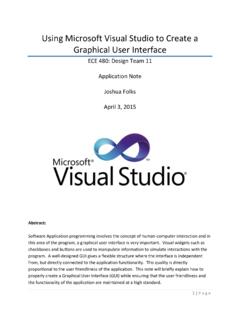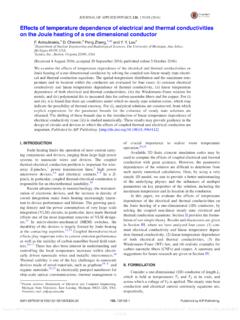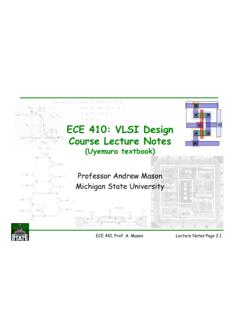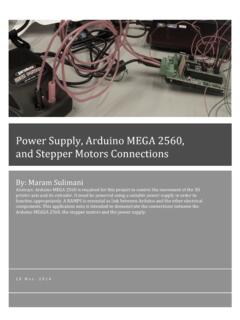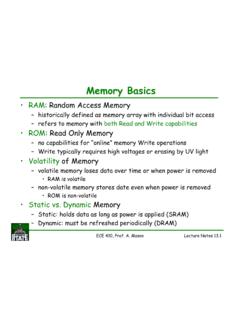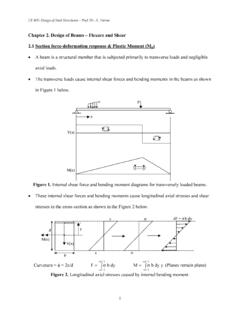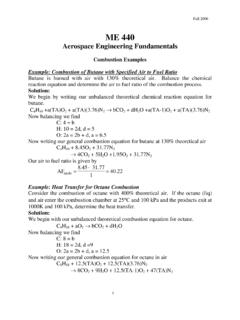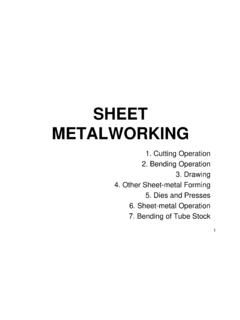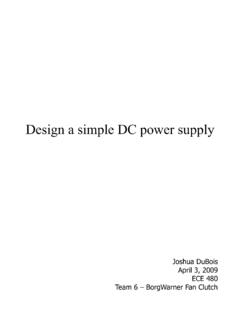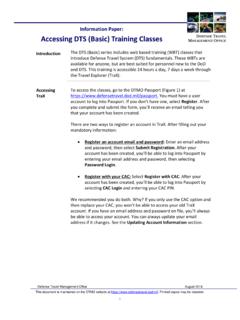Transcription of Fatigue - Michigan State University
1 Term fatigueintroduced by Poncelet (France) 1839progressive fractureis more descriptive Fatigue1. Minute crack at critical area of high local stress(geometric stress raiser, flaws, preexisting cracks)2. Crack gradually enlarges(creating beach marks )3. Final fracture(suddenly, when section sufficiently weakened) Fatigue : no or only microscopic distortionstatic failure: gross distortion 3. Final fracture(rough zone)1. Fatigueorigin2. Beach marks(velvety zone) Fatigue Repeated plastic deformation Thousands/millions of microscopic yielding(far below conventional yield or elastic point) Highly localized plastic yielding(holes, sharp corners, threads, keyways, scratches, corrosion) Strengthen vulnerable locationoften as effectiveas choosing a stronger material (If local yielding is sufficiently minutestrain-strengthen may stop the yielding)Standard Fatigue Strength Sn Empirical data from Moore Fatigue test(Highly standardized and restricted conditions)Rotating-beam Fatigue -testingmachinePure bending (zero traverse shear)Ncycles of tension-to-compression-to-tension1750 rpmvariousStandard Fatigue Strength Sn Fatigue strength, or Peak alternating stress S (ksi)Linear coordinates (not used for obvious reason)Semilog coordinatesLog-log coordinatesFerrous materials: for life cycle N > 106 < Sn Knee.
2 106< N <107 Scattered dataEndurance Limit Sn Endurance Limit Sn Endurance Limit Sn Sn = x Su( x Sufor cast iron) Fatigue StrengthS-N curve approximation for steelSu/ksi= x Hardness (also Bhn)Hence Sn /ksi = x HBfor HB<400103-cycle Fatigue : S1000= x SuS/Su(log)106 Endurance LimitS-N curve for nonferrous metalsaluminum alloys No Sharply defined kneeand No Trueendurance limit( Fatigue strength at N=5x108often used)Sn = x Su(for Su< 48 ksi)(like for cast iron) Fatigue strength at N=5x108 Tensile Strenght Su(ksi)Su(MPa)Life N (cycles)Endurance LimitS-N curve approximationEndurance limitSteel Sn = x SuCast Iron AluminumMagnesiumSn = SuNickel alloysSn = x SuCooper alloys Sn = x SuTitaniumSn = x Su@ N=106@ N=108Sn = x SuEndurance LimitReversed Bending (not rotating bending like in Moore testing)maximum stressesonly @ top and bottomhigh probability not weakest pointRotating Bending (Moore testing)maximum stresseson surfaceweakest point Fatigue startFatigue strength usually slightly greaterdeliberately neglected safe sideReversed Axial Loadingmaximum stressesentire cross sectionno reserve !
3 Fatigue strength about 10% lesseccentric loads about lessCG= factorReversed Torsional Loadingreversed biaxial stressdistortion energy theory 58%CL= factormaximum stresseson surfaceshear stressesfatigue startEndurance LimitFatigue StrengthJuvinall Sus= SuOther ductile material Sus= SuFatigue StrengthInfluence of SurfaceSo far special mirror polish surface (only in laboratory ! )Minimizes 1.) surface scratches (stress concentration)2.) differences of surface & interior material3.) residual stresses from finishingCommercial surfaceshave localized pointsof greater Fatigue factor CSUse only for endurance limit !+ cast ironFatigue StrengthInfluence of SizeReversed Axial Loadingmaximum stressesentire cross sectionno reserve ! Fatigue strength about 10% lesseccentric loads about lessCG= factorlarge specimen> CG= CG= CG= test specimenUse equivalent round section !Bending & Torsional Reversed Loadingsmall specimen< CG= 1 Fatigue StrengthSn= Sn CLCGCSS ummery use Table Juvinall strength (endurance limit)Sn.
4 Moore endurance limit1000-cycle strengthBendingAxialTorsionCL(load factor) : Sus= ductile metals: Sus= (load factor) (gradient factor)< ..2 ..4 r e d u c e - 4 ..6 r e d u c e - (surface factor)see Fig. : D=25mm, Su = 950 MPa, Sy= 600 MPa, reversed axially loaded, steel, hot-rolled surfaceFind: Sn(2x105life cycles) Fatigue StrengthFluctuating stress= static stress + completely reversed stressmean +alternatingEffect of mean stressFatigue StrengthEffect of mean stressStatic tensile stressreducesamplitudeof reversed stress that can be superimposedMacroscopic Yielding on first load applicationMicroscopic Yielding empiric conceptSySnSu-Sn a mFatigue StrengthEffect of mean stressCompressive mean stressdoes not reduce amplitudethat can be superimposedSy-SySySn a- m(compression) m(tension)Goodman linesempiric conceptSuValues from S-N curve ( m=0)No macroscopic yieldingExtends infinite for Fatigue (only static failure Suc)Juvinall Fig.
5 Fatigue diagramFatigue StrengthJuvinall StrengthEffect of mean stresstest datasteel alloyaxial loading min m a maxGoodman lineSuSnNote: Brittle materials are usually on Goodman lineFatigue StrengthEffect of mean stressSySuSy- m(compression) m(tension) Sn=Sn CLCGCS=( ) ksiSu=150 ksipolishedfor N=106& 103 d= ?< 2in loadAlb6000 ASFxFmm== mSF=2 Alb4000 ASFxFa== a a(N=106)=38ksi d= < 3/8 in a(Sy)=48ksi d= <11/32in S= StrengthStress concentration()q1K1 Ktf +=geometric or theoretic factorApply Kfto mean stress mand to alternating stress factorKf<Ktbendingaxial loadtorsionSu/ksiqnotch r [in]Cast iron q=0higly notch sensetiveq 1
